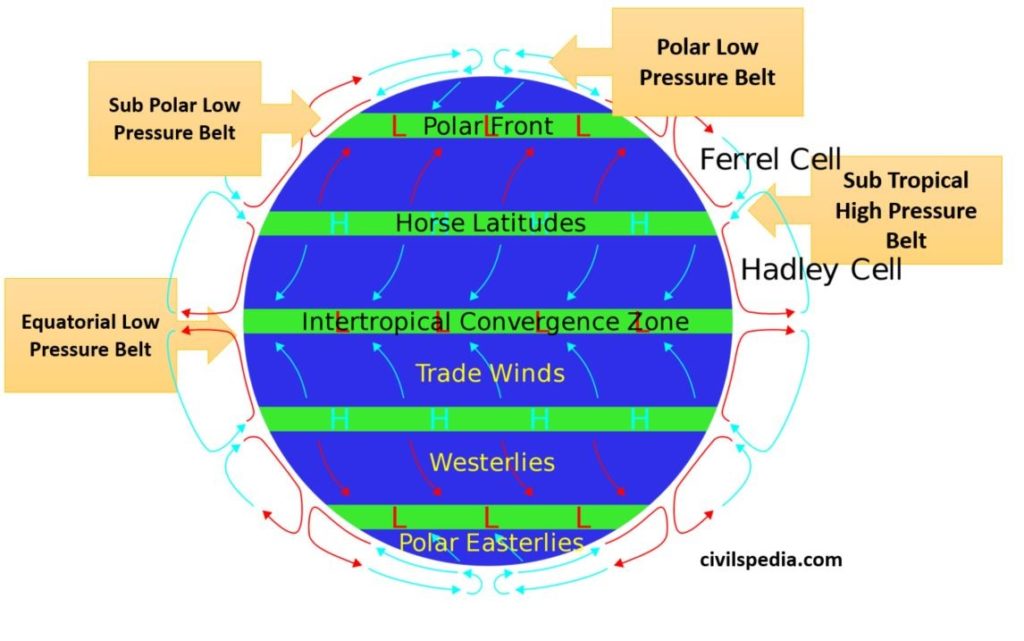
PRESSURE BELTS AND THEIR SEASONAL VARIATIONS Environment
Shifting of Pressure Belts - Geography Video | Iken EduGeography video lecture explaining about Pressure belts in atmosphere. Learn about the shifting of pr.

Pressure Belts of Earth, Types, Diagram, Shifting of Pressure Belts
Nov 10, 2023 Pressure belts are the areas of the Earth that are dominated by either high or low-pressure cells. These pressure belts are distributed all over the Earth in seven places. There are seven pressure bands on the earth's surface. These are the Equatorial Low, the two Subtropical highs, the two Subpolar lows, and the two Polar highs.

Pressure and Pressure Belts
Next Pressure Belts and Planetary Winds Pressure varies from one place to the other place and also decreases with altitude resulting in world pressure belts and planetary winds. Atmospheric pressure is nothing but the force exerted by the atmospheric column on a unit area of earth's surface.

Pressure Belts INSIGHTSIAS
Let's turn now to actual global surface wind and pressure patterns, shown in Figure 5.17. The subtropical high-pressure belts, created by the Hadley cell circulation, are important features. In the northern hemisphere, they include two large high-pressure cells that flank North America—the Hawaiian and Azores highs.
Pressure Belts of the World Geography for Competitive Exams APPSC Material, Group 1 Group 2
Draw a well labelled diagram showing the pressure and wind belts of the earth. Answer. Below labelled diagram shows the pressure and wind belts of the earth: Question 2(a) Briefly explain the three chief types of winds. Answer. The three chief types of winds are-

PPT Global Pressure Belts PowerPoint Presentation, free download ID214594
Earth's Atmospheric Circulation System. The global atmospheric circulation system influences the movement of air masses in general wind belts that move air in rotating masses within zones around the planet. These wind belts seem relatively stable when viewed in a long-term view (decades). However, fluctuations may occur on seasonal or annual.

How Pressure Belts Change the Weather DISCOVERSIO YouTube
Pressure belts are those areas on the surface of the earth where the same pressure is distributed differently based on latitude. These are developed due to High or Low-Pressure cells. These high- or low-pressure cells produce high- or low-pressure belts.

Pressure and Pressure Belts
60oN and 60oS, the low-pressure belts are termed as the sub polar lows. Near the poles the pressure is high and it is known as the polar high. These pressure belts are not permanent Figure 10.2 : Distribution of pressure (in millibars) — January Figure 10.1 : Isobars, pressure and wind systems in Northern Hemisphere velocity.
Raja Babu Pressure Belts and Winds
Pressure Belts of the Earth refer to the regions that are dominated either by high-pressure cells or low-pressure cells. The high and low-pressure belts are arranged alternatively on the Earth's surface. The pressure belts are formed on the earth's surface because Warm air is light, and the air at the Equator rises, creating low pressure.

a neat diagram showing pressure belts label the diagram Brainly.in
Pr essure Belts of Earth On the earth's surface, there are seven pressure belts. They are the Equatorial Low, the two Subtropical highs, the two Subpolar lows, and the two Polar highs. Except for the Equatorial low, the others form matching pairs in the Northern and Southern Hemispheres.

Pressure and Pressure Belts
The air from sub-polar low pressure belts after saturation becomes dry. This dry air becomes cold while moving towards poles through upper troposphere. The cold air (heavy) on reaching poles subsides creating a high pressure belt at the surface of earth. Climate. The lowest temperatures are found over the poles. Pressure belts in July

C5Pressure Belts,Permanent Winds upsc iasCoriolis Force, Easterlies,Westerlies,Doldrums YouTube
The diagrams above and below portray just the Hadley cell circulation, that is driven by heating in the equatorial region. On the surface, wind moves away from high pressure (High) and toward low pressure (Low).. and Divergence occurs under the descending air that forms high-pressure belts. The final figure (Figure 26) shows all six cells.

Introduction to Pressure Belts, Isobars and Associated Weather (Horizontal & Vertical Wind
2. Sub-Tropical High-Pressure Belts These belts extend roughly between 25 degrees and 35 degrees latitudes in both Hemispheres. These belts are formed due to the rising air of the equatorial region, which is deflected towards the poles because of the earth's rotation. After becoming cold and heavy, it descends in these regions and piles up.

Pressure Belts 6th Std Geography English Medium Maharashtra Board Home Revise YouTube
Pressure belts. The Hadley Cell is set up by rising air over the equator. It begins with warming of air surrounding the equator, which creates a large region of lower surface pressures (due in part to the fact that columns of warm air weigh less than columns of cold air). This belt of equatorial low pressure causes air to be drawn together in a.

Chapter 14 Atmospheric Pressure and Winds Solutions for Class 9 ICSE Total Geography Morning
The orientation or direction of a pressure gradient is always described as being from higher toward lower pressure. The speed of the wind is controlled by the strength of the pressure gradient, the stronger the pressure gradient the higher the wind speed. The strength of the pressure gradient can be discerned from the spacing of isobars on a.

Surface pressure distribution with all four pressure belts Download Scientific Diagram
Key Concepts In this lesson we will focus on summarising what you need to know about: The mechanics present to create global wind and pressure belts as a response to the unequal heating of the atmosphere The relationships between air temperature, air pressure and wind